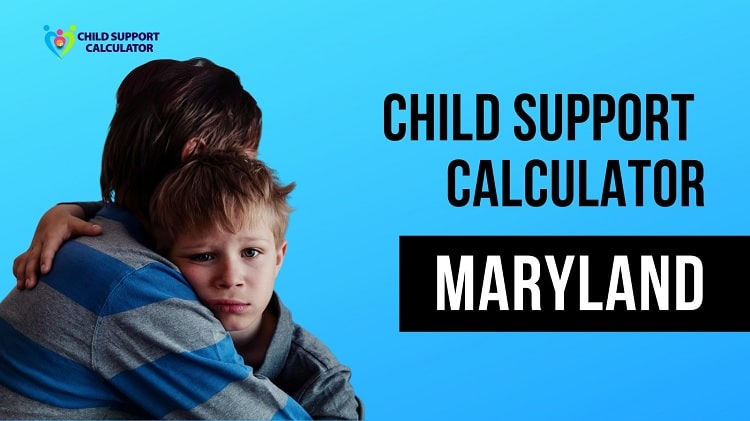Child Support In Maryland Calculator – Guidelines – 2024
Child Support calculator in Maryland uses the “Income Shares Model,” which calculates the money parents spend on their children while living in the same residence (known as “combined adjusted actual income” in MD). Based on their wages, this sum is shared between the parents. In other words, under the Income Shares Model, each parent will be awarded a support amount depending on their income.

How Child Support Is Calculated In Maryland
It is calculated on the factors like:
- The “actual monthly income” of each parent – For most individuals, “actual monthly income” involves pay or earnings, Bonuses, Social Security benefits, workers’ compensation benefits, alimony, and other sources of income might all be included. Actual revenue excludes temporary cash assistance, food stamps, Supplemental Security Income, and other means-tested public assistance payments.
- Each parent’s “adjusted actual income” – Real income less any pre-existing child support and alimony that the parent pays for another child equals adjusted actual income.
- Work-related child care expenses – This can cover daycare expenditures as well as before and after-school care while a parent is at work.
- Extraordinary medical expenses – Braces, dental treatment, asthma treatment, physical therapy, and psychological counseling are examples of charges that are not covered by insurance.
- Financial Statement –If you are seeking child support, you must submit a financial statement to the court. It’s critical that you complete the financial statement entirely and truthfully. If you lie on the form, you might be prosecuted with perjury. The form’s objective is to assist the court in making a fair decision to assist your children.
Maryland Child Support Guidelines
Maryland’s child support calculator standards allow parents to assess their support obligations by combining their wages and the number of children they share. Each parent is allotted a share of the overall support obligation depending on their income percentage.
If parent A earns $6,000 per month and parent B earns $4,000 per month, parent A is liable for 60% of the support (6,000 divided by 10,000), while parent B is responsible for 40% of the support (6,000 divided by 10,000). (4,000 divided by 10,000).
To acquire an appropriate average child support amount, several processes are necessary, and the standards are quite complicated. Custody and visitation arrangements are made in MD.
Support payments may be influenced by alimony awards and child support orders from past partnerships.
The Maryland Courts website’s Family Law section has paperwork and support guidelines for parents who are conducting their own child support case. To estimate how many children support a judge would likely order in your case, download and complete a Financial Statement Form DR 30 and a Child Support Guidelines Worksheet; either Worksheet
- A—Primary Physical Custody Form DR 34 or Worksheet
- B—Shared Physical Custody Form DR 35 in most circumstances.
It may be difficult to navigate the materials on your own. In the end, a court will only impose a average child support sum if it is in the best interests of the kid. Contact an attorney if you need help with the papers or calculations.
You may also use the Maryland Department of Human Services child support calculator, but keep in mind that it won’t take into account any changes for parenting time or other special situations.
Worksheet A or B
If you and your child’s other parent have a parenting arrangement in which one of you has primary physical custody and the other receives court-ordered visitation that totals less than 35 percent of overnights each year, this form should be utilized.
The entire amount of assistance is distributed between the parents based on their respective shares of income in the main parent computation, with no adjustment for parenting time. Courts believe that the custodial parent’s portion is already going toward the direct costs of rearing children.
As a result, only the non-custodial parent (the one who does not have primary custody) will be required to pay average child support. If each of you has the children for at least 35 percent of the year, utilize Worksheet B. (shared custody).
The Maryland rules reflect that under shared parenting agreements, both parents must maintain a child’s full-time residence, resulting in an overall increase in both the total cost of raising children and each parent’s expenses.
In the shared custody calculation, the basic child support requirement (from the guidelines’ schedule) is multiplied by 1.5. Following that, the additional support is distributed amongst the parents depending on their wages and parenting time (percentage of time or number of days per year that a child spends with each parent).
There are several phases to this procedure. Worksheet B will bring you through the computation step by step, as explained in the directions.
Deviation Of Maryland Support Guidelines
The court may order a different amount than the guideline amount in specific cases (called a “departure” or “deviation”). A court may conclude that separation is appropriate if one parent is already paying the mortgage and costs for the other parent to continue living in the marital home, or if one spouse has additional expenses for children from another relationship.
A judge will normally evaluate any financial stipulations contained in a property settlement agreement or a court order.
In that scenario, findings must be recorded in either the court record or the order itself, explaining the guideline amount, how the order departs from that amount, and why the deviation is in the children’s best interests.
Modification and Termination of Child Support
A parent who wishes to modify (alter) a child support order must prove a significant and continuous change in circumstances after the court has established the first order. A new, higher-paying job for one parent or a significant difference in the parents’ custody arrangement are two examples of developments that merit revision.
If a change in the child support rules would increase or decrease the support amount by at least 25%, a parent might request a modification.
In MD, a child’s duty to pay child support usually ceases when the kid reaches the age of 18. If the youngster is still in high school, the court may prolong the duty until the child is 19.
Adjusted Actual Income
Earned or unearned pretax income is usually included in real income. Wages, commissions, military pay, self-employment earnings, disability payments, and investment income are all typical examples. If you’re self-employed, you can deduct necessary business expenditures from your gross receipts to estimate your actual income, but be aware that the deductions you can take are limited and don’t include all the IRS permits. The suggestions and definitions portion of Form DR 30 contains a description of what to include in actual income (Financial Statement).
Any child support or alimony you pay under a previous court ruling might be deducted from your adjusted real income. If you get alimony payments, you must include them in your income.
In addition to considering real income, if a court feels a parent chooses not to work or work at a lower-paying job than the parent is eligible for, the court may impute (assign) income and increase the parent’s child support obligation proportionately.
Adjustments for Additional Expenses
You can make some restricted changes after assessing the minimum support requirement, such as health insurance premiums, unusual medical expenditures, and work-related child-care expenses that either parent is paying directly.
A judge may also alter child support to account for any court-approved special education expenditures or transportation costs that the parents have agreed to split. Whether you use the single parenting or shared parenting formula, you’ll divide responsibility for these expenditures solely on the basis of income share, with no consideration for parenting time.
Collecting and Enforcing Child Support Orders
You’ll need to collect payments once you’ve obtained a child support order. Even though both parents are allotted a share of child support under a Maryland support order, only the non-custodial parent is required to pay support to the other parent directly.
It is now simple to pay child support. An obligor parent can pay support by cash, check, direct deposit, or payment applications like Venmo or Zelle unless your court order specifies otherwise.
The Maryland Department of Human Resources (DHS) is in charge of assisting parents in obtaining and enforcing child support orders, as well as identifying missing parents and, if required, establishing paternity.
Receiving Maryland Child Support
The Maryland Child Support Enforcement Program (CSEP), a branch of the Department of Human Resources, is in charge of child support problems in Maryland. The CSEP may assist divorced families in a variety of ways. The CSEP can help you whether you reside in Gaithersburg, Bowie, Hagerstown, Rockville, Baltimore, Frederick, or anywhere in the state:
- The non-custodial parent’s location
- Establishing paternity in the eyes of the law
- Obtaining a child support and health insurance court order
- Collecting child support payments is a difficult task.
- Putting the court’s order into effect
- Reviewing and altering the amount of child support awarded by the court
When it comes to collecting child support payments from your kid’s non-custodial parent, the CSEP has a few options:
- Taking money from unemployment benefits and salaries is a bad idea.
- Tax returns from both the state and the federal government should be intercepted.
- The credit bureau should be notified about the late payer.
- If a parent owes money to the Motor Vehicle Administration, their driver’s license may be suspended.
- Keep track of lottery wins.
- Take legal action against delinquent parents for contempt of court.
- When non-custodial parents flee the state to avoid child support, cases are referred to the federal government.
Parenting time
If the non-custodial parent has less than 25% of parenting time (fewer than 92 overnight visits per year) in the visitation plan, use Worksheet A for primary physical custody. If both parents have at least 25% parenting time, use Worksheet B for shared physical custody. The number of overnights the child spends with each parent is used to calculate shared physical custody. If the paying parent has 92–94 overnights each year, their responsibility increases by 10%.
- 8 percent if they have 95–98 overnights
- 6 percent if they have 99–102 overnights
- 4 percent if they have 103–105 overnights
- 2 percent if they have 106–109 overnights
- 0 percent if they have 110 or more overnights
Does my new spouse’s income count in the Child Support formula?
No, it does not. In Maryland, the Child Support calculation considers the parents’ earnings. There are a few instances where contributions from a third party, such as a new spouse, can be added to one of the parents’ incomes, but the new spouse’s income is generally excluded from the child support computation.
What Happens When You Don’t Comply With the Maryland Child Support Enforcement Program?
The organization has the ability to do a lot of things. If you don’t pay, they can garnish your earnings and negotiate with your employer to ensure you don’t receive the money you owe. This also applies to withholding and even retaining tax refunds.
They can call the credit bureau in Maryland to ensure that there is some damage to your credit. Many people in Maryland are surprised to learn that they may have their driver’s license suspended.
Over the years, the organization has been compelled to become tighter due to many parents choosing to ignore child support obligations.
Is there a minimum amount of child support in the Maryland child support guidelines calculator or formula?
There is no set amount that must be paid in child support. In other cases, the court will deem both parents jointly liable for child support, which means no money would travel from one parent to the other. When the child support Calculator formula returns a minimal, low monthly amount, this nearly invariably happens.
Bottom Line
Child Support calculator in Maryland requirements can vary greatly from one family to the next, based on income, the number of children, and the children’s costs. Because the calculator is only as good as the numbers we enter into it, it’s critical to get the numbers accurate. Don’t make the mistake of overpaying or underpaying.







